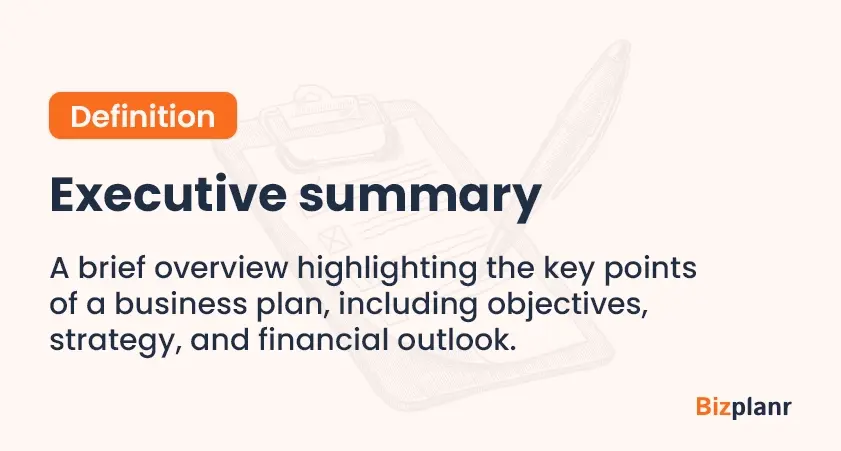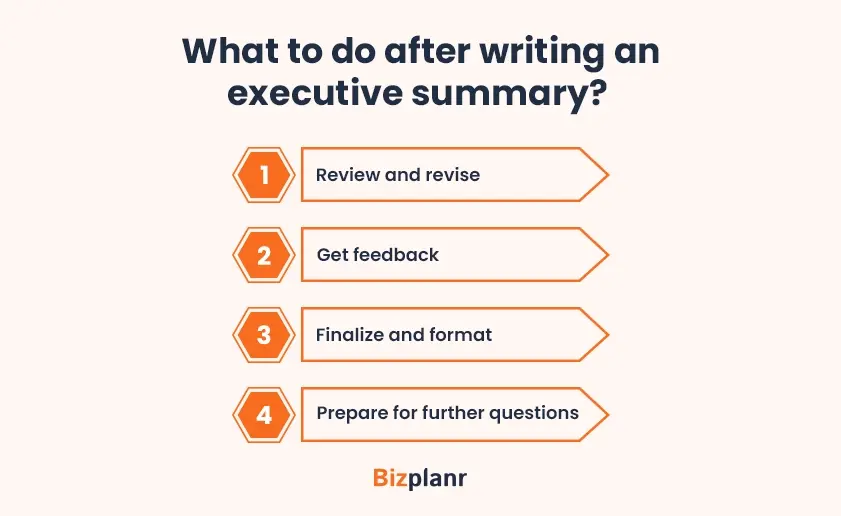Imagine you’re about to ask someone out on a first date!
You’ve got just a few moments to make the all-important first impression—so what do you say? Would you prefer a long speech or something short, sweet, and unforgettable?
Well, crafting an executive summary in a business plan is just like that all-important first impression moment.
You've limited time to grab the attention of any reader and show them that your business is worth investing in. Who knows, maybe even bag a second date (meeting 😉).
So in this blog, we’ll simplify how to create an executive summary that’s engaging. Let's get started!
What is an executive summary in a business plan?
An executive summary is a short overview of a business plan. It gives a quick snapshot of what the business is about, what it offers, who it serves, and how it'll make money.
It also highlights the business goals, products or services, market opportunity, financial outlook, and the team behind the business.
As the first section of a business plan, its purpose is to grab the reader's attention and encourage them to explore the further details.
How to Write a Executive Summary in a Business Plan?
An executive summary is the first glance at the business plan, and writing it effectively is necessary. It not only captures the essence of your business but also piques the interest of potential investors or partners. Let's see how to write one:
1) Start with a compelling introduction
Begin your summary with a powerful opening that immediately captures attention. A compelling fact, statistic, or bold statement can set the stage effectively.
This introduction briefly mentions your business name and the core purpose of your venture. By starting strong, you engage the reader right from the beginning, making them eager to delve deeper into your business plan.
Matt Bellerose, founder of LobsterOrder, highlighted the power of a "rejection-proof" opening in an effective executive summary.
He shared, "We opened with a stunning statistic: '90% of seafood in the US comes from imports, often of questionable quality.' It set the stage for our solution." This approach shows how a compelling introduction can attract the readers to read the business plan.
2) Give the company description
After capturing attention with a compelling introduction, provide a clear and concise description of your company. It should briefly cover your business's name, location, company history (if any), ownership, and core activities.
This description establishes the identity and scope of your business, offering necessary background information to the reader.
Additionally, mention your business structure, such as whether it's a startup, family-owned, or a corporation, and specify the current stage of your business, whether it's in the starting phase, development, or another stage.
3) State the problem and solution statement
Clearly state the specific challenge or market need that your business addresses. This section should highlight the significance of the problem and why it demands a solution.
Then, present your solution, detailing how your product or service effectively resolves the problem. Explain what makes your solution unique or superior to existing alternatives. This typically means you’ve to introduce your Unique Selling Proposition (USP) here.
As Peter Drucker famously said, "The aim of marketing is to know and understand the customer so well the product or service fits him and sells itself." Likewise, your problem and solution statement should show how your business is perfect to meet the market's needs.
4) Outline market analysis
Here, highlight the size of the market, your target audience, and key trends that show demand for your product or service.
Including strong statistics can make this section more impactful. For example, Kevin Shahnazar, founder of FinlyWealth, used the "3-2-1 Method" in his executive summary.
He started with three key market insights, like "68% of credit card holders are using the wrong card for their spending habits, potentially losing thousands in rewards annually." This approach quantified the market potential and emphasized the need for his solution.
Your market analysis should clearly define your target market and its growth potential, making a strong case for your business's success.
5) Explain your business model
This section should define how your business plans to generate revenue. Start by describing the primary revenue streams—product sales, subscriptions, services, or something else.
Next, explain your pricing strategy and how it syncs with the expectations of your target market.
Highlight the unique aspects of your business model that provide a competitive edge, such as a cost-effective production process, unique distribution method, etc.
By providing a clear explanation of your business model, you help readers understand how your business will operate and generate revenue.
6) Describe your marketing and sales strategies
Begin by identifying what sets your product or service apart and use this unique feature as the base of your marketing strategy. Explain how you’ll use this advantage to attract your target audience.
Also, mention the channels you’ll use, like social media, content marketing, or partnerships, to reach and engage your customers.
Dan Khasis, founder and CEO of Route 4 Me, suggests enhancing your strategy with an impact statement that highlights the broader effect your business will have.
This impact statement should show how your marketing efforts will contribute to a larger cause. But keep the impact statement of the marketing plan short and simple to understand.
7) Introduce your management team
Here, mention the key members of your management team. Start by introducing each member, and mentioning their roles and responsibilities.
Provide a brief overview of their background, experience, and any achievements or awards. Emphasize how their skills will contribute to the success of your business.
A strong management team can build confidence among readers, reassuring them that your business is in capable hands.
8) Highlight financial forecasts
This section provides a brief overview of your business’s financial summary and projections.
Start by stating key figures such as expected revenue, profit margins, and cash flow over the next few years. This gives readers a sense of your business’s financial health and potential for growth.
Include projected break-even analysis, ROI (Return on Investment), and expected expenses. Make sure your forecasts are realistic with practical expectations.
If you're raising funding, then mention your ask amount at the end. A realistic financial plan shows readers that your business is stable.
Now that you know how to craft a compelling executive summary, the next crucial question is…
Benefits of an Executive Summary in a Business Plan
An executive summary is more than just an introduction to your business plan, it offers various benefits like:
Allows quick decision-making
The executive summary allows potential investors and partners to evaluate the validity of your business idea. By providing a concise overview, it helps them make informed decisions without having to go through the entire business plan.
Acts as a standalone
Sometimes, readers might not have time to read the full business plan. Then, a well-crafted summary comes into play. It serves as a standalone document that covers all the necessary information about your business.
Sets the strategic direction
The summary doesn't just introduce your business plan—it also sets the strategic direction for your business. By clearly mentioning your goals, objectives, and strategies, an executive summary serves as a roadmap for success.
Builds credibility and trust
An effective summary shows your professionalism and thorough understanding of your business. By clearly including your business strategy, market analysis, and financial projections, you show that you have done your homework. This also shows that you’re serious about your business and committed to its success.
To take all these benefits, you need a solid executive summary, let's go ahead and see how to write one.
How Long Should an Executive Summary Be?
Well, an executive summary should be one to two pages long. As the purpose here is to provide only a short overview of the whole business plan.
Plus, potential investors or partners have limited time, and the executive summary is the first thing they'll read. So, it needs to be short enough to catch their attention while still covering all the necessary details.
Just focus on clarity, ensuring that every sentence adds value. Avoid going into too much detail—leave that for the other sections of the business plan.
Common executive summary mistakes to avoid
One of the most common errors is writing the summary first, rather than at the end. It’s better to write it last so that you’ve got a clear idea of the whole business plan.
Another mistake is not customizing your summary to your audience. It's important to customize your summary to address the specific needs of different groups, whether they’re investors, partners, or others.
Finally, avoid using jargon or buzzwords, and focus on clear as well as simple language that effectively communicates your message. By avoiding these, you can create an executive summary that’s clear and engaging.
What to do after writing an executive summary?
Once you've completed your executive summary, here are a few steps you need to take to make your summary efficient. Here's what you should do next:
Review and revise
Once, you've written the executive summary, take a break and return for reviewing. This break allows you to review or revise the summary with a fresh perspective. Check for consistency and clarity too. As Ernest Hemingway famously said, “The first draft of anything is crap.” Revising allows you to refine your ideas and ensure your summary is to the point.
Get feedback
Share your executive summary with colleagues, mentors, or friends for more insights. They can offer a different view and help identify areas that might need corrections. Then use the same feedback to change the summary that syncs with your target customers.
Finalize and format
Once you're sure about the content, focus on the formatting now. A well-formatted executive summary is easy to read and understand. Use headings, bullet points, short paragraphs, and visuals. A clean and organized format will make your summary engaging.
Prepare for further questions
Potential investors or partners might have questions. Be prepared to think about all the aspects of your summary. Familiarize yourself with all the aspects of the executive summary, so you confidently answer all the queries.
Executive Summary vs. Business Plan
An executive summary is a brief overview of the entire business plan. It summarizes key points such as business goals, products or services, market opportunities, financial projections, and the management team.
Whereas, a business plan is a comprehensive document that details every aspect of the business. It includes strategies, market analysis, operations, financial plans, and more.
In brief, the executive summary is a short description of the important aspects of your business plan in 1 to 2 pages. On the other hand, the business plan is a detailed document of around 15-30 pages.
Executive Summary Example
Here's an example of the executive summary for GreenLeaf Organic Farms. This example will guide you through each section, so let's walk through it:
Business name: GreenLeaf Organic Farms
Location: Napa Valley, California
Type of business: Organic farming and distribution
Overview
GreenLeaf Organic Farms is an organic farm in Napa Valley dedicated to growing high-quality, sustainable fruits and vegetables. Our mission is to provide healthy, organic produce to consumers while protecting the environment through sustainable farming practices.
Problem
Consumers are increasingly worried about the use of pesticides and GMOs in their food, but there aren’t enough reliable sources of organic produce to meet this demand. The market is in need of consistent, high-quality organic options.
Solution
GreenLeaf Organic Farms will fill this gap by offering a variety of organic fruits and vegetables that are grown sustainably and available year-round. Our produce is GMO-free, pesticide-free, and packed with nutrients, making it the perfect choice for health-conscious consumers.
Market analysis
The U.S. organic food market is booming, expected to reach $70 billion by 2025. Napa Valley is an ideal location for our farm, with a strong local demand for organic produce. Our target customers include local grocery stores, farmers' markets, and direct online sales.
Business model
We generate revenue by selling our produce through local stores, farmers' markets, and online subscriptions. Our pricing is competitive, reflecting the high quality of our products. By focusing on sustainable farming, we also reduce costs and increase our competitive edge.
Marketing and sales strategies
Our marketing will emphasize the health and environmental benefits of our organic produce. We’ll use social media, partnerships with influencers, and content marketing to reach our target audience. We’ll also highlight how our farming practices contribute to a more sustainable future.
Management team
GreenLeaf is led by John Doe, who has over 20 years of experience in organic farming, and Jane Smith, who specializes in scaling agricultural businesses. Together, they bring the expertise needed to grow GreenLeaf into a successful and sustainable business.
Financial forecasts
| Year | Revenue | COGS | Operating expense | EBITDA |
|---|---|---|---|---|
| 1 | $1,000,000 | $400,000 | $300,000 | $200,000 |
| 2 | $1,200,000 | $480,000 | $320,000 | $250,000 |
| 3 | $1,500,000 | $600,000 | $340,000 | $350,000 |
| 4 | $1,800,000 | $720,000 | $360,000 | $420,000 |
| 5 | $2,100,000 | $840,000 | $380,000 | $480,000 |
Funding requirements
We are seeking $500,000 in investment to cover startup costs, including land, equipment, and initial operations. This investment will enable us to establish GreenLeaf as a leader in the organic farming market.
Conclusion
Crafting a great executive summary is your first step toward securing investment or partnership for your business.
Remember, a clear and concise summary can make all the difference. If you're feeling stuck or need a little help drafting your summary or the whole business plan, then Bizplanr is here to help.
It helps you create a professional business plan in no time. Try yourself out Bizplanr today!
Get Your Business Plan Ready In Minutes
Answer a few questions, and AI will generate a detailed business plan.
Frequently Asked Questions
Does an executive summary need a title?
Yes, an executive summary needs a title. The title "Executive Summary" clearly indicates to the reader what this section is and sets the stage for what follows. It helps to organize the document and ensures that readers can quickly locate the summary when reviewing the business plan.
What are the 5 parts of the executive summary?
An executive summary includes five parts and they’re:
- Background
- Problem
- Solution
- Findings
- Conclusion
Can an executive summary be more than one page?
Yes, an executive summary can be more than one page, but it's recommended to keep it as short as possible. The ideal length of an executive summary is 1-2 pages so, keep this length in mind.








